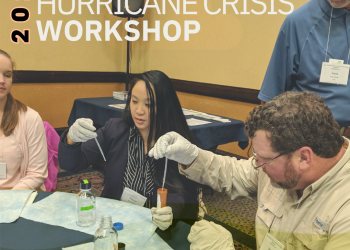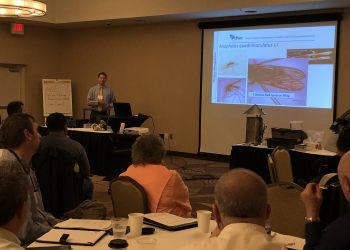 This post is part of NACCHO’s Retail Program Standards blog series showcasing the progress that communities across the country have made in retail food protection. Each month, we are featuring the experiences, challenges, and successes of jurisdictions that have worked toward each of the U.S. Food & Drug Administration’s (FDA’s) Voluntary National Retail Food Regulatory Program Standards (Retail Program Standards). These Standards are designed to help food regulatory programs enhance the services they provide to the public.
This post is part of NACCHO’s Retail Program Standards blog series showcasing the progress that communities across the country have made in retail food protection. Each month, we are featuring the experiences, challenges, and successes of jurisdictions that have worked toward each of the U.S. Food & Drug Administration’s (FDA’s) Voluntary National Retail Food Regulatory Program Standards (Retail Program Standards). These Standards are designed to help food regulatory programs enhance the services they provide to the public.
All jurisdictions featured have participated in NACCHO’s Retail Program Standards Mentorship Program, which provides peer-to-peer assistance and intensive technical support to help jurisdictions conform with the standards efficiently and effectively.
This month we are focusing on Standard 4: Uniform Inspection Program, and we have responses from two jurisdiction:
- Jana Childers, Environmental Director, Angelina County & Cities Health District, Lufkin, TX
- Whitney Wright, Environmental Health Manager, Rappahannock-Rapidan Health District (Virginia Department of Health), Warrenton, Virginia
What steps did you take to get started in your work on Standard 4?
Childers: Our initial step was to determine where our agency stood in conformance with Standard 4 by conducting an updated self-assessment. Additional research was then performed on criteria identified as not met to further comprehend the amount of work effort required for both environmental staff and administration. After analyzing which areas needed the most improvement, an action plan was developed assigning deadlines to meet criteria and ensure consistent progress on Standard 4 compliance.
Wright: We took advantage of NACCHO’s Retail Program Standards Mentorship Program, and we were paired with a mentor, Fairfax County Health Department. Our health district met the verification audit for Standard 2 the previous year, and we saw Standard 4 as a good complement to a standardized food safety training program. We completed a self-assessment of all nine standards and saw Standard 4 as one we thought we could meet with a little extra effort.
What was your biggest challenge in working toward Standard 4, and how have you worked to overcome that challenge?
Childers: Our biggest challenge in working toward Standard 4 was limited staff. Our jurisdiction has a small number of inspectors and the potential for bias did exist when carrying out reviews under the quality assurance program. We have worked to overcome that challenge by first establishing the need for discussion and constructive criticism to ultimately improve the quality of inspections performed for the greater benefit of consumers. Another possible solution was to reach out to neighboring jurisdictions for assistance completing field and file reviews to provide more accurate and unbiased quality assurance inspections.
Wright: One challenge for us was budgeting time for working on Standard 4. We found that participation in the mentorship program was helpful to schedule time for working on the Standards and to identify key personnel to work on various aspects of the Standard through a “divide and conquer” approach. As we worked through the development of our quality assurance policy document, file audit form, and field audit form we found ourselves editing the policy and forms several times to meet the needs of our district.
What outcomes and benefits came out of working on Standard 4?
Childers: We developed and implemented the first quality assurance program in history for our jurisdiction, which will help promote quality inspections for years to come. Our agency is now able to easily identify which areas inspection staff may need to improve upon, and we can also create a snapshot of how our jurisdiction is operating in its entirety. Working on this Standard has increased our knowledge of uniformity and performance, and we are conducting higher quality inspections within our agency. This has helped reduce complexity of regulatory requirements for retail food owners and operators promoting a reduction in foodborne illness risk factors. Additional benefits from working on this Standard under the mentorship program included peer-to-peer networking opportunities to communicate and collaborate with professionals across the nation all working toward the same goal.
Wright: One of the major benefits of working on Standard 4 from a program management perspective is it ensures uniform, high-quality inspections are conducted in a professional manner, at a frequency based on risk assessment and compliance status with an efficient use of time and program resources. The quality assurance program identifies deficiencies in quality and consistency and highlights areas of improvement in training, mentoring and/or coaching for the food safety staff. It also identifies best practices and reinforces good inspection practices.
How do you sustain momentum in your work on Standard 4?
Childers: We sustained momentum by continuously referring to the action plan initially developed in our work on the Standard. In the plan, deadlines were set in a way that consolidated sub-element criteria into narrowed down groups allowing for steady and continuous achievement. Accomplishing one small victory at a time really helped motivate inspection staff to complete deliverables within the timeframe allowed. Eventually, our agency was able to realize that obtaining a verification audit by project end was very possible with the resources and tools we received in the mentorship program.
Wright: It is certainly easy to lose momentum working towards the Standards with all the other day-to-day regulatory responsibilities associated with a food safety program. You have to make working on the Standards part of your work schedule, and it is critical to engage staff in the process. It is also important to remember that a quality assurance program is a necessary part of proving quality work for our community and an important driver in refocusing our expectations.
What tips do you have for other jurisdictions working toward Standard 4?
Childers: We recommend utilizing the FoodShield Mentorship Program Workgroup to research quality assurance forms and policies from multiple agencies. [Ed. Note: Only mentorship program participants can access this workgroup. For others interested in viewing jurisdictions’ policies and forms, sign up for the FDA Retail Program Standards Workgroup on FoodSHIELD or view examples on NACCHO’s website.] This enabled us to invest more time into actual program implementation rather than documentation content and design. In addition, FoodShield resources allowed us to pull the most helpful information from various programs to best fit the needs of our jurisdictional operation.
Wright: For food safety regulatory programs that are not enrolled in the Retail Program Standards, we recommend going to their website and contacting your FDA Regional Food Specialists to learn more about the program. For programs that are already enrolled, we would recommend doing what we did and consider the NACCHO mentorship program. Working with a mentor who has experience in the Standards is one of, if not the most valuable resource for getting started in any of the Standards. The mentorship program also provides valuable resources from across the country through a workgroup on FoodSHIELD where mentorship program participants can post and share resources for all of the Standards.
How has your work on the Retail Program Standards overall affected your community in terms of public health outcomes?
Childers: Our work on the Standards has improved our relationship with industry and consumers by providing a better understanding of regulatory requirements and uniformity, while increasing inspection staff competence and confidence in the field. Overall, the Standards have advanced our local agency operation to a more effective, efficient, and up-to-date program for preventing foodborne illnesses to a greater extent in our community.
Wright: The Virginia Department of Health’s vision statement is, “Become the healthiest state in the nation.” As an environmental health manager for the Rappahannock-Rapidan Health District, one of 35 health districts in Virginia, I see the Standards as a food safety management tool that provides a standard of excellence for the food safety program in our district. Our food program’s overarching goal is to have zero foodborne outbreaks within our community and to do that you have to have a sound food safety program that is balanced. The Standards provide that balance. Completing Standard 2 and our work to date on Standard 4 have already improved our approach to training new staff and focusing on new training areas for our experienced staff.
Stay tuned for the next post, which will focus on Standard 5: Foodborne Illness and Food Defense Preparedness and Response, coming in February.
Contact Amy Chang at [email protected] with any questions.






